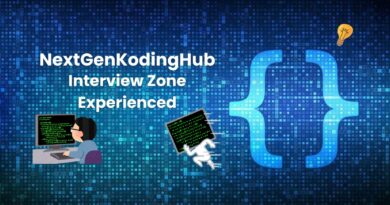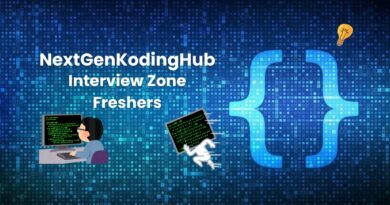Data Scientist Interview
Interview Preparation: Data Scientist Role
Data Scientist Interview – 30+ Expert-Level Questions and Detailed Answers
A successful Data Scientist Interview requires mastering key concepts in statistics, machine learning, programming, and data handling. This guide provides over 30 advanced questions frequently asked in Data Scientist Interview rounds, designed to boost your expertise and confidence. From data preprocessing to model evaluation, this comprehensive resource targets critical areas employers focus on.
Throughout your Data Scientist Interview preparation, understanding the theoretical and practical aspects of data science is essential. These questions will help you articulate complex ideas clearly and showcase your ability to solve real-world problems using data.
1. What is the difference between supervised and unsupervised learning?
Supervised learning uses labeled data to train models for classification or regression, while unsupervised learning finds hidden patterns or groupings in unlabeled data through clustering or dimensionality reduction.
2. Explain the bias-variance tradeoff.
Bias is error from incorrect assumptions; variance is error from sensitivity to small fluctuations in training data. The tradeoff balances underfitting (high bias) and overfitting (high variance) for optimal model performance.
3. How do you handle missing data?
Techniques include removing rows/columns, imputing with mean/median/mode, predicting missing values using ML models, or using algorithms that support missing data inherently.
4. Describe the differences between L1 and L2 regularization.
L1 (Lasso) adds absolute value of coefficients as penalty promoting sparsity, useful for feature selection. L2 (Ridge) adds squared coefficients penalty, shrinking weights but keeping all features.
5. What is the curse of dimensionality?
As the number of features increases, data points become sparse in the feature space, making distance-based algorithms less effective and increasing model complexity.
6. Explain principal component analysis (PCA).
PCA reduces dimensionality by projecting data onto orthogonal components that capture maximum variance, simplifying data visualization and improving model efficiency.
7. What metrics do you use to evaluate classification models?
Accuracy, precision, recall, F1-score, ROC-AUC, confusion matrix, and sometimes log-loss depending on the problem.
8. How do you prevent overfitting?
Use cross-validation, regularization, early stopping, pruning, dropout (for neural nets), and increase training data or simplify models.
9. What is the difference between a Type I and Type II error?
Type I error is a false positive—rejecting a true null hypothesis. Type II error is a false negative—failing to reject a false null hypothesis.
10. How do decision trees work?
Decision trees split data on features to create branches, aiming to reduce impurity (Gini index, entropy). Leaves represent class labels or regression values.
11. Explain the concept of cross-validation.
Cross-validation partitions data into folds to train and test multiple times, reducing overfitting risk and providing a robust model evaluation.
12. How does a random forest improve over a single decision tree?
It builds multiple trees on random subsets of data and features, averaging their predictions to reduce variance and improve accuracy.
13. What is gradient descent?
An iterative optimization algorithm that updates model parameters to minimize a loss function by moving in the direction of the negative gradient.
14. Explain the difference between batch, stochastic, and mini-batch gradient descent.
Batch uses the whole dataset for each update, stochastic uses one sample at a time, and mini-batch uses small random subsets to balance convergence speed and stability.
15. How do you select important features?
Techniques include filter methods (correlation, chi-square), wrapper methods (recursive feature elimination), embedded methods (Lasso), and tree-based feature importance.
16. What are the differences between classification and regression?
Classification predicts discrete class labels; regression predicts continuous numeric values.
17. How do you handle imbalanced datasets?
Use resampling (oversampling minority, undersampling majority), synthetic data (SMOTE), cost-sensitive learning, or evaluation metrics like ROC-AUC and F1-score.
18. What is the role of activation functions in neural networks?
Activation functions introduce non-linearity, enabling neural networks to learn complex patterns. Examples: ReLU, Sigmoid, Tanh.
19. Describe how you would approach a new data science project.
Understand business objectives, acquire and clean data, exploratory data analysis, feature engineering, model selection and training, evaluation, tuning, deployment, and monitoring.
20. What is overfitting and underfitting in machine learning?
Overfitting occurs when a model learns noise and performs poorly on new data; underfitting occurs when a model is too simple and cannot capture underlying patterns.
21. Explain A/B testing and its significance in data science.
A/B testing compares two versions of a variable to identify which performs better statistically, guiding data-driven decisions.
22. How do you deal with multicollinearity?
Detect with VIF (variance inflation factor), remove or combine correlated features, or use regularization techniques.
23. What is the difference between parametric and non-parametric models?
Parametric models assume a fixed form and number of parameters (e.g., linear regression), while non-parametric models can grow complexity with data (e.g., k-NN).
24. Explain the Central Limit Theorem.
The CLT states that the distribution of sample means approaches a normal distribution as sample size grows, regardless of the population’s distribution.
25. How do you evaluate clustering results?
Use internal metrics like silhouette score, Davies-Bouldin index, or external metrics like adjusted Rand index if true labels exist.
26. Describe the difference between Type I and Type II errors with examples.
Type I error: Detecting a fraud when there is none (false alarm). Type II error: Missing an actual fraud (false negative).
27. How do you explain machine learning results to non-technical stakeholders?
Use simple visualizations, analogies, focus on business impact, and avoid jargon to make insights accessible and actionable.
28. What is feature scaling and why is it important?
Scaling normalizes features to a standard range (e.g., 0–1), improving algorithm convergence and performance, especially for distance-based models.
29. Explain the difference between bagging and boosting.
Bagging builds multiple independent models on bootstrapped data and averages results to reduce variance. Boosting builds sequential models that focus on previous errors to reduce bias.
30. What is a confusion matrix?
A table summarizing true positives, false positives, true negatives, and false negatives to evaluate classification model performance.
Bonus Questions:
31. How do you handle time series forecasting?
Use techniques like ARIMA, exponential smoothing, or LSTM networks. Address seasonality, trends, stationarity, and evaluate with metrics like MAPE or RMSE.
32. What are embeddings and how are they used?
Embeddings convert categorical or textual data into dense vectors capturing semantic relationships, widely used in NLP and recommendation systems.
Conclusion
Preparing for a Data Scientist Interview involves a blend of statistical theory, coding skills, and practical problem solving. This comprehensive question set targets the advanced topics most often explored in experienced data science roles. Review, practice explaining your answers, and apply these concepts in projects to boost your confidence and interview success.



